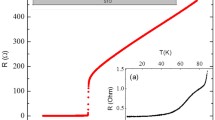Abstract
The proximity effect in MoRe/Al sandwiches with different critical temperatures T c of MoRe films has been studied. The estimation of the proximity effect parameters has been made and their dependence on the Al thickness built. Features associated with instability of nonequilibrium superconducting state have been observed in the current-voltage characteristics of MoRe/Al–I–Pb tunnel junctions as a result of quasiparticle tunnel injection into the MoRe/Al sandwich. The estimation of the parameter of tunnel injection has been made and its impact on instabilities emergence studied. MoRe–I–Pb tunnel junctions have been produced and their current-voltage characteristics studied to be compared with the results obtained.





Similar content being viewed by others
References
C.S. Owen, D.J. Scalapino, Phys. Rev. Lett. 28, 1559 (1972)
W.H. Parker, Phys. Rev. B 12, 3667 (1975)
V.F. Elesin, Yu.V. Kopaev, Sov. Phys. Usp. 24, 116 (1981)
P. Verhoeve, N. Rando, A. Peacock, A. van Dordrecht, A. Poelaert, D.J. Goldie, R. Venn, J. Appl. Phys. 83, 6118 (1998)
P.A.J. de Korte, Nucl. Instrum. Methods Phys. Res., Sect. A, Accel. Spectrom. Detect. Assoc. Equip. 444, 163 (2000)
P. Lerch, A. Zehnder, in Cryogenic Particle Detection, ed. by Ch. Enss (Springer, Berlin, 2005), pp. 217–266
S. Friedrich, M.H. Carpenter, O.B. Drury, W.K. Warburton, J. Harris, J. Hall, R. Cantor, J. Low Temp. Phys. 167, 741 (2012)
L.R. Testardi, J.J. Hauser, M.H. Read, Solid State Commun. 9, 1829 (1971)
A.A. Golubov, E.P. Houwman, J.G. Gijsbertsen, V.M. Krasnov, J. Flokstra, H. Rogalla, M.Yu. Kupriyanov, Phys. Rev. B 51, 1073 (1995)
J. Talvacchio, M.A. Janocko, J. Greggi, J. Low Temp. Phys. 64, 395 (1986)
S.P. Chockalingam, M. Chand, J. Jesudasan, V. Tripathi, P. Raychaudhuri, Phys. Rev. B 77, 214503 (2008)
C. Kittel, Introduction to Solid State Physics, 7th edn. (Wiley, New York, 1996), pp. 353, 150, 160
C.C. Chi, J. Clarke, Phys. Rev. B 20, 4465 (1979)
E.M. Rudenko, D.S. Dubyna, A.A. Krakovny, J. Appl. Phys. 113, 173909 (2013)
D. Movshovitz, N. Wiser, Phys. Rev. B 41, 10503 (1990)
P. Liu, Ph.D. dissertation, Rice University, Houston, Texas, 1971
R.C. Dynes, V. Narayanamurti, J.P. Garno, Phys. Rev. Lett. 39(4), 229 (1977)
K.E. Gray, H.W. Willemsen, J. Low Temp. Phys. 31, 911 (1978)
E.M. Rudenko, I.V. Korotash, A.A. Krakovny, D.S. Dubyna, D.A. Solomakha, D.S. Shchyptsov, J. Low Temp. Phys. 171, 779 (2013)
G.P. Pepe, G. Peluso, R. Scaldaferri, A. Barone, L. Parlato, R. Latempa, A.A. Golubov, Phys. Rev. B 66, 174509 (2002)
S.B. Kaplan, C.C. Chi, D.N. Langenberg, J.J. Chang, S. Jafarey, D.J. Scalapino, Phys. Rev. B 14, 4854 (1976)
F.J. Morin, J.P. Maita, Phys. Rev. 129(3), 1115 (1963)
G. Gladstone, M.A. Jensen, J.R. Schrieffer, in Superconductivity, vol. II, ed. by R.D. Parks (Dekker, New York, 1969), pp. 733–734
E. Lerner, J.G. Daunt, Phys. Rev. 153(2), 487 (1967)
Author information
Authors and Affiliations
Corresponding author
Appendix
Appendix
It is known from [22] that electronic specific heat coefficient for Mo0.5Re0.5 alloy γ ∗=10.5×10−4 cal K−2 mol−1. The value of DOS at the Fermi energy N(0) for the Mo0.5Re0.5 alloy with the dimension of states eV−1 cm−3 will be determined, considering that [23]:
where k B is the Boltzmann constant. At first, we find volume V occupied by one mole of the Mo0.5Re0.5 alloy, using the formula:
where Mr is molecular mass and ρ—the density of MoRe alloy. The MoRe molecular mass will be equal to the sum of Mo and Re atomic masses: Mr(MoRe)=Ar(Mo)+Ar(Re)=96+186=282 g/mol, while ρ for Mo0.5Re0.5 compound is determined from the relation:
where ρ(Mo)=10.28 g/cm3 and ρ(Re)=21.02 g/cm3 are densities, x and y—percent compositions in Mo x Re y compound of the Mo and Re, respectively. Then, the Mo0.5Re0.5 compound density will be equal to ρ(Mo0.5Re0.5)=13.8 g/cm3. Converting cal into eV, we could write the electronic specific heat coefficient as γ ∗=1.34×1015 eV K−2 cm−3 and, using equation (16), find that the DOS for Mo0.5Re0.5 N(0)=2.75×1022 states eV−1 cm−3.
The value of coherence length for the Mo0.5Re0.5 \(\xi^{*}_{\mathrm{MoRe}}\) is found, using the Ginzburg-Landau (GL) expression for type-II superconductors:
where H c2 is the upper critical field, Φ 0—the magnetic flux quantum. In [24], upper critical fields of the Mo0.52Re0.48 alloy for different T/T c ratios were found. Taking into account bath temperature T=4.2 K, the T/T c ratios for our films with critical temperatures T c =9.5 K and T c =6.5 K were 0.442 and 0.646, respectively. Then, the nearest similar values for upper critical fields of the Mo0.52Re0.48 alloy were H c2=1.28 T (T/T c =0.424) and H c2=0.61 T (T/T c =0.666) [24]. Substituting these values into (19), we obtain \(\xi^{*}_{\mathrm{MoRe(a)}}\approx16~\mathrm{nm}\) and \(\xi^{*}_{\mathrm{MoRe(b)}}\approx23~\mathrm{nm}\).
To check these values, let us calculate the GL coherence length \(\xi ^{*}_{\mathrm{MoRe}}\) through the ξ MoRe(0)—MoRe coherence length in the clean limit. It is known that for the dirty superconductor \(\xi^{*}_{\mathrm{MoRe}}\) relates to ξ MoRe(0) as:
where l MoRe is electron mean free path (mfp) in the MoRe film. At the same time, ξ MoRe(0) could be determined from the BCS theory:
where \(v_{F}^{\mathrm{MoRe}}\) is electron velocity on the Fermi surface, Δ MoRe(0)—MoRe energy gap value at T=0 K, and ħ—Planck constant. mfp l MoRe could be expressed by the relations:
where e is elementary charge, D is diffusion coefficient, which is obtained as:
Thus, expression (20) could be re-written as:
As was shown in [10], MoRe, if its thickness is not less than 20 nm, is BCS superconductor with weak coupling, so energy gap Δ MoRe(0) could be found from the BCS theory:
Then, from (25) the following values of the energy gaps were obtained: \(\varDelta_{\mathrm{MoRe(a)}}(0)\,{\approx} 1.44~\mbox{meV}\) and \(\varDelta_{\mathrm{MoRe(b)}}(0)\approx1~\mbox{meV}\) for the films with T c =9.5 K and T c =6.5 K, respectively. Substituting our values into (24), we obtain \(\xi^{*}_{\mathrm{MoRe(a)}}\approx17~\mathrm{nm}\) and \(\xi^{*}_{\mathrm{MoRe(b)}}\approx8~\mathrm{nm}\).
Rights and permissions
About this article
Cite this article
Dubyna, D.S., Rudenko, E.M., Krakovny, A.A. et al. Instability of Nonequilibrium Superconducting State and the Proximity Effect in MoRe/Al Sandwiches. J Low Temp Phys 173, 327–342 (2013). https://doi.org/10.1007/s10909-013-0902-x
Received:
Accepted:
Published:
Issue Date:
DOI: https://doi.org/10.1007/s10909-013-0902-x



